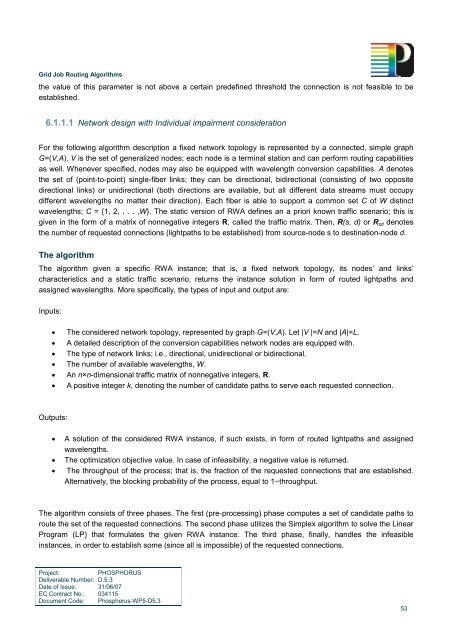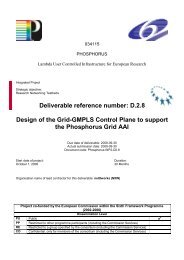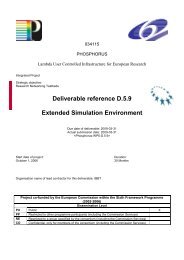Grid Job Routing Algorithms - Phosphorus
Grid Job Routing Algorithms - Phosphorus
Grid Job Routing Algorithms - Phosphorus
You also want an ePaper? Increase the reach of your titles
YUMPU automatically turns print PDFs into web optimized ePapers that Google loves.
<strong>Grid</strong> <strong>Job</strong> <strong>Routing</strong> <strong>Algorithms</strong>the value of this parameter is not above a certain predefined threshold the connection is not feasible to beestablished.6.1.1.1 Network design with Individual impairment considerationFor the following algorithm description a fixed network topology is represented by a connected, simple graphG=(V,A). V is the set of generalized nodes; each node is a terminal station and can perform routing capabilitiesas well. Whenever specified, nodes may also be equipped with wavelength conversion capabilities. A denotesthe set of (point-to-point) single-fiber links; they can be directional, bidirectional (consisting of two oppositedirectional links) or unidirectional (both directions are available, but all different data streams must occupydifferent wavelengths no matter their direction). Each fiber is able to support a common set C of W distinctwavelengths; C = {1, 2, . . . ,W}. The static version of RWA defines an a priori known traffic scenario; this isgiven in the form of a matrix of nonnegative integers R, called the traffic matrix. Then, R(s, d) or R sd denotesthe number of requested connections (lightpaths to be established) from source-node s to destination-node d.The algorithmThe algorithm given a specific RWA instance; that is, a fixed network topology, its nodes’ and links’characteristics and a static traffic scenario, returns the instance solution in form of routed lightpaths andassigned wavelengths. More specifically, the types of input and output are:Inputs:• The considered network topology, represented by graph G=(V,A). Let |V |=N and |A|=L.• A detailed description of the conversion capabilities network nodes are equipped with.• The type of network links; i.e., directional, unidirectional or bidirectional.• The number of available wavelengths, W.• An n×n-dimensional traffic matrix of nonnegative integers, R.• A positive integer k, denoting the number of candidate paths to serve each requested connection.Outputs:• A solution of the considered RWA instance, if such exists, in form of routed lightpaths and assignedwavelengths.• The optimization objective value. In case of infeasibility, a negative value is returned.• The throughput of the process; that is, the fraction of the requested connections that are established.Alternatively, the blocking probability of the process, equal to 1−throughput.The algorithm consists of three phases. The first (pre-processing) phase computes a set of candidate paths toroute the set of the requested connections. The second phase utilizes the Simplex algorithm to solve the LinearProgram (LP) that formulates the given RWA instance. The third phase, finally, handles the infeasibleinstances, in order to establish some (since all is impossible) of the requested connections.Project:PHOSPHORUSDeliverable Number: D.5.3Date of Issue: 31/06/07EC Contract No.: 034115Document Code: <strong>Phosphorus</strong>-WP5-D5.353






